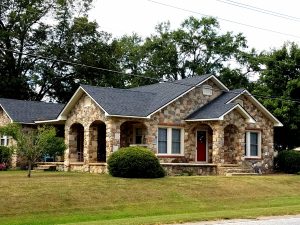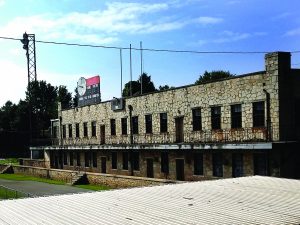Still praying for the victims of Flo and thanking God for the reduced initial intensity of the storm. And maybe by the time this is printed, it will be cooling off, acting like autumn.
A lot is happening in the area that is positive in this time of stress though. I’m excited to say that the construction has begun on Holly Spring School. This African American clapboard school building is the second oldest school still standing in the state. It has rested off the Belton Highway in western Greenville County since the 1870s. Several groups have come together to support its preservation. Fork Shoals Historical Society, Preservation South, 1st Class Construction, and Holly Springs Baptist Church are major contributors to the construction. Kyle Campbell of Preservation South has worked to acquire the needed materials through donations and has pulled together the needed expertise with the aid of 1st Class. Work will continue on Fridays until complete sometime this fall.
Fork Shoals Historical Society is working on other projects as well. One is researching a story. This story came to me through Jim Scott, society president. There are a number of stone houses along US 25 from Moonville to Ware Shoals.
These homes are from the era of just after the Great Depression and probably prior to WWII, late 1930s. Most of the ones in Greenville County are in relatively good condition and still lived in. Many of you are very aware of their presence for they stand out as different from the local farm houses, white clapboard style, of the area. So, Jim and I went on a field trip to Ware Shoals where we met Mr. George Estes who lead us to stone structures around that fair town. George has become a Ware Shoals historian and we were blessed to have him as a guide. Along with the stone buildings, we visited a grist mill site from the mid-1800s, an Indian mound, graveyards, and we heard the stories key to these sites. The weather was lovely and it was a great day for tromping through the wilds of Ware Shoals.
But, to get back to the rock houses, George shared the Ware Shoals Field House. I couldn’t believe it! The athletic fields and the Field House were blasted out of bedrock in the 1930s. When the school district chose a big gulley to pull their football and baseball fields up from, they hit rock. Forced to blast to flatten one part of the area, they were provided with the materials for the Field House. A gentleman came forward to help. He was a stonemason who may have come up from Georgia through Abbeville. According to the local story, this African American craftsman required only the following as remuneration; $5 a week, all the food he could eat, and beer each day. Supposedly, he was able to face and lay about 2 rocks a day. It must have taken months to complete the Field House just noting the size of it – 2 stories and at least 100 ft. long.
After this magnificent structure was completed, our mason continued north toward Greenville plying his craft.
Evidence of his work along Augusta Rd. begins just before you get to Princeton going up from Ware Shoals. On the right, now almost completely hidden by trees, is a striking house set back from the road. At one time there were stone arches at the highway designating the ends of the circular drive. I remember it well from my travels toward Greenwood over the years. I always slowed to take in its beauty. Sadly, now this home is abandoned and needs to be loved again.
Moving into Greenville County several homes present themselves. Just above Princeton is Dr. Knight’s house on the left. It is a unique, two-story structure and the first floor is of stone. Then moving to Ware Place (also named for members of the Ware family of Ware Shoals), I know of three houses of stone. If you notice, the rock changes as you follow the trail north. I suspect that local materials were supplied by the property owners and fieldstone is evident here where the Field House looks to be granite. Just north of the Ware Place intersection on the right is a modified stone home with some additions. Currently for sale, it also needs some love. Then just before you reach Ellen Woodside Elementary School and on the left is another home beautifully cared for. With many exterior archways and porches, it is one of the nicest examples. Directly across the highway is a vacant lot. Little evidence of the stone work that once stood proudly here is visible now. This home burned and was then demolished a number of years ago.
According to the story, this great mason continued to work his way to Greenville constructing more homes. One may be in Simpsonville belonging to Simpsonville First Baptist Church. It sits just across the street from the front of the church and belonged to my friend’s, Barbara Adams, aunt. She tells many great stories about that house and I believe it belongs to the church. It is beautifully restored.
I’m sure that there were other stone masons working in the area around the same time, but I would love to find more of the story of this great craftsman. Which of these structures did he craft? What was his name? Does he have family still here? Who might know more of his story? I’m hoping to hear from some of you. I have searched for newspapers relating to the Field House, found an article about the mills’ construction of the building, but no mention of the stonemason, of course. Any hints would be appreciated! Help me recreate the story of one man’s gift.
acpeden07@gmail.com
Hoping to hear from you, Moonville Mae
Anne Peden, Phd.
Greenville County Historic Preservation Commission
Fork Shoals Historical Society
Piedmont Historical Preservation Society
Bonnes Amies Service Club
Co-Author, Images of America, Fork Shoals
Co-Author, Images of America, Piedmont♦



